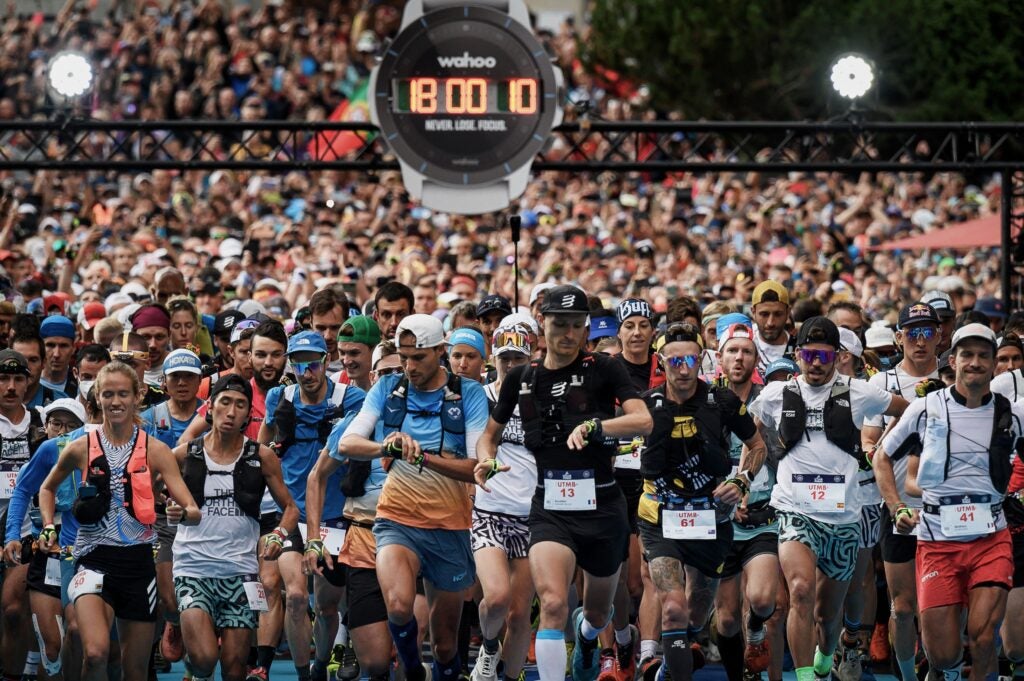
Heading out the door? Read this article on the new Outside+ app available now on iOS devices for members!
>”,”name”:”in-content-cta”,”type”:”link”}}”>Download the app.
The Running Industry Diversity Coalition (RIDC) recently launched its #FreedomToRun campaign for Juneteenth on June 19, releasing a series of three studies on racial representation in running participation and industry employment. These studies were produced in partnership with Bentley University, providing in-depth analyses and first-of-its-kind research to establish a baseline measure for progress toward racial justice. This research was funded by Altra, Brooks, New Balance, On, Patagonia, Salomon, Saucony, Smartwool, and Strava, and has important takeaways for the entire trail community
What Is the RIDC?
RIDC is a 501(c)(3) nonprofit that was established in October 2020, at the height of the Covid-19 pandemic and in the wake of the tragic deaths of Ahmaud Arbery, George Floyd, and Breonna Taylor, which sparked a social justice reckoning across nearly every industry, including the running industry. The organization was founded with the goal of increasing employment opportunities and running participation amongst Black, Indigenous, and People of Color (BIPOC) in the U.S. by establishing transparency and measuring accountability among organizations.
According to data from the Sports and Fitness Industry Association (SFIA), approximately 34 percent of runners (16 million people) are people of color, which highlights why it’s imperative for key players in the industry to address issues related to systemic racism and a lack of inclusivity, especially as the U.S. population is growing increasingly more racially diverse, with people of color projected to be the majority by 2045.
RELATED: State of the (Trail Running) Union: Eight Takeaways From a New International Survey
Diversity within trail and ultra-running
Notably, one of the studies, “Racial Diversity in Trail Running: Understanding the Underrepresented Experience,” focused on the trail and ultra-running community, which many runners who are Black, Indigenous, or People of Color, have described as being one of the least welcoming corners of the running space.
It’s especially noteworthy that this research was released now, as more running organizations, brands, and individuals alike have grown hesitant to discuss racism within the sport after the high volume of conversations surrounding the 2020 movements inevitably died down, and especially since key players in the trail scene have been hesitant to address issues of systemic racism to begin with. RIDC executive director Kiera Smalls noted that it’s important to recognize that the running industry has regressed in terms of keeping conversations about racism going as we’ve moved further away from 2020.
“Many companies have become more hesitant to publicly address these issues, contributing to a lack of progress in addressing the systemic challenges faced by runners of color,” Smalls says.
RIDC co-founder and former chair Alison Mariella Désir also emphasized the need for the trail and ultramarathon community to come to terms with the fact that it is dominated by thin white men and women who have always seen themselves represented and who have never faced challenges due to the color of their skin.
“The few racialized folks within that community that also claim that there is no racial bias perhaps have also never faced discrimination,” Désir says. “Therefore, when someone points out the obstacles or the reality of just how white the space is, the immediate reaction is to deny that it is a possibility based on their own limited personal experiences or those around them. This fragility perpetuates a reluctance to make any real, systemic shifts to the current system in place.”
Key study findings
A main finding of the trail running study was that BIPOC runners hold significant concerns regarding trail and road running and racing. These include barriers to access, safety, and inclusion during trail competitions, as well as unorganized participation, unaddressed product needs, and comparisons to road running experiences.
For this study, RIDC surveyed 1,138 total respondents, 79 percent of which were people of color. While, on the whole, respondents noted they enjoy trail running, they largely find it to be exclusionary. A prominent example was that while the majority of respondents described the experience as “fun,” white runners frequently described the field as “inclusive,” whereas runners of color rarely used that same descriptor.
Universally, across all racial identity groups, the sentiment was that the nature of trail running is less focused on time and more on experience, explains Erin Flynn, a professor of marketing at Bentley University and a lead researcher on the studies who has also been involved with RIDC since its inception. This makes for less pressure and a sense of community that is really strong and it shapes the culture, according to both white and BIPOC respondents.
RELATED: Meet the Women Creating a More Egalitarian Future in Running
“[However], the difference is white respondents feel they can experience those benefits of the lack of pressure, the sense of community, and all the positives that trail learning without worrying about the negative pieces that come from being the only member of a racial identity group,” Flynn explains. “So when white participants are using inclusive, they’re saying, ‘yeah, it’s inclusive for me, it’s so community-oriented, people are cheering for me, and it’s an awesome experience. [Meanwhile,] our BIPOC respondents were saying, I feel all those things, but it’s also extremely white. People around me don’t look like me, I’m being singled out and asked questions or just treated differently than the other people who are showing up there, and that creates a negative experience.”
The study also showed that 47 percent of Black and Brown trail runners engage in the sport for the functional benefits (such as improving or maintaining physical health), while white runners are more concerned with the emotional advantages, with 21 percent citing “connecting with nature” as their primary reason for engaging in the sport.
The study also found that runners of color have a greater sense of safety on trails than they do on roads, as predators tend to be animals rather than humans who could potentially wield weapons. At the same time, though, BIPOC runners reported feeling significantly less safe than white runners during trail and road races, with 56 percent of Black and brown runners saying they always feel safe at trail races compared to 80 percent of white runners.
Runners of color expressed unmet needs across product relevance and function, with 16 percent of survey respondents indicating that current footwear offerings on the market are not meeting their overall trail running needs, and 23 percent saying the same for current apparel offerings.
Another key study finding was that, qualitatively, runners of color don’t feel valued as consumers.
“Both our trail and road studies shed light on the challenges runners of color face, both as consumers and athletes, with one prominent issue being the lack of inclusive product offerings that meet the needs of individuals from diverse backgrounds,” Smalls says. “[One example was] concerns regarding the limited availability of apparel that accommodates various body sizes and hairstyles, making it difficult for runners of color to find suitable and comfortable gear.”
Where trail events are falling short
On a general level, large road running events such as the World Marathon Majors are lagging when it comes to tracking racial demographic information among its participants, which has undoubtedly contributed to setbacks in progress, Smalls says. It’s no surprise popular trail races don’t have this information readily available either, but one can easily infer what the demographics are by following these races in real-time.
Notably, this year’s Western States Endurance Run made waves for offering just two complimentary entries to BIPOC runners, one of which ended up going unused. Désir called attention to the flaws contributed by the lottery system used by many iconic trail races. While lottery systems are meant to be random, they will skew toward participants with the privilege to be able to bank multiple race finishes, and in turn, accrue more lottery tickets, as a result of having more free time and the income to do so. This ends up resulting in almost exclusively white participants.
[I believe key players in the trail space] are apathetic [to these issues] because the current system benefits them, and so long as people continue to sign up for their races and they continue to get sponsors, there’s no sense of urgency, because if the current system benefits them, why would they speak out against it?
“This is clearly not a fair lottery, and yet the lottery system remains virtually unchallenged,” she says.
When Désir started a discussion on Instagram about the lack of representation at this year’s Western States race, and the lack of willingness among trail running brands and professional athletes to speak up, she predictably received backlash from event supporters.
“[I believe key players in the trail space] are apathetic [to these issues] because the current system benefits them, and so long as people continue to sign up for their races and they continue to get sponsors, there’s no sense of urgency, because if the current system benefits them, why would they speak out against it?” Désir says. “So much of what I hear from folks within that world when even small changes occur is that they wish that things could go back to how they used to be; that the sport is becoming too commercial, and too many new people are coming into the sport and ruining the purity of it. They are interested in preserving their spaces for themselves and welcoming newcomers and changes to tradition feels like a threat to their authenticity and even identity.”
RELATED: This Essential Race Director Toolkit Supports Inclusion and Sustainability
What comes next
One key aspect of enacting tangible change is increasing financial accessibility to trail runners of all levels, Désir says. For runners at the recreational level, this demonstrates how complimentary entries for these races that are otherwise hard to gain entry to simply isn’t enough, as runners have to also factor in the expenses of trail-specific gear and equipment, as well as travel and lodging to these races, often held in remote areas.
“I’ve had conversations with sports agents that have shared with me that they have super talented East African athletes who would just dominate if they entered the trail and ultra running scene but the fact that they would be unable to support themselves financially while doing so has deterred them from participating,” Désir says. “There’s no denying the athleticism and talent we are witnessing within the trail and ultra-running space, but do I believe these folks are the ‘Greatest of All Time?’ Absolutely not. Only when there is equity within the sport that allows for fuller participation will we begin to truly know that we are seeing ‘G.O.A.T.-level’ participation and talent.”
This post was originally published on this site be sure to check out more of their content.







